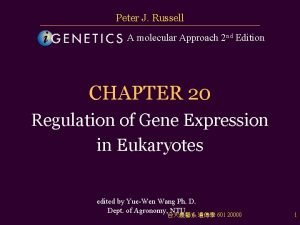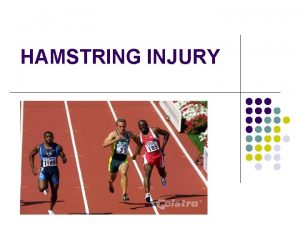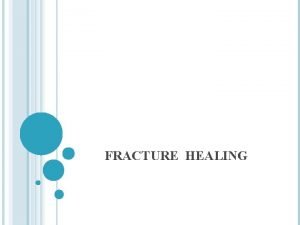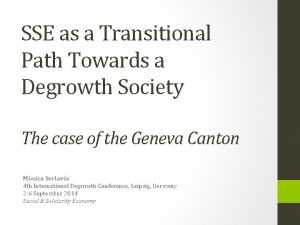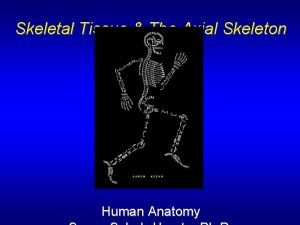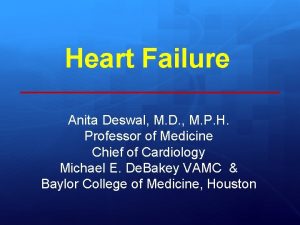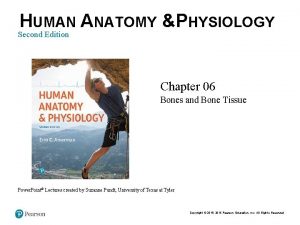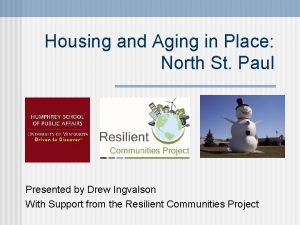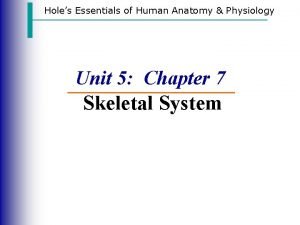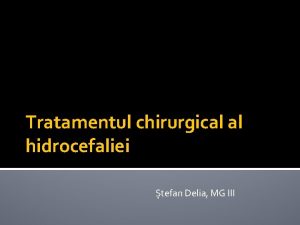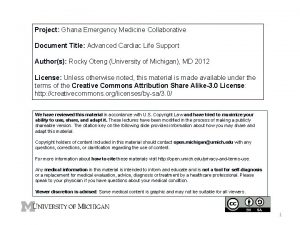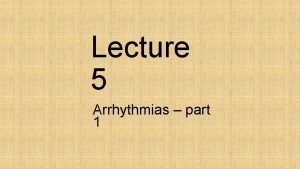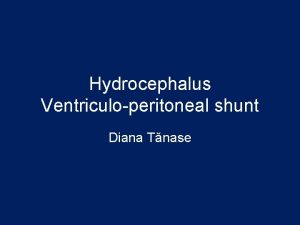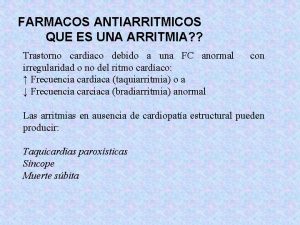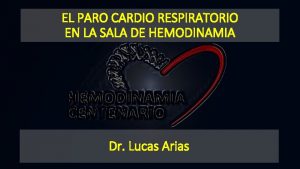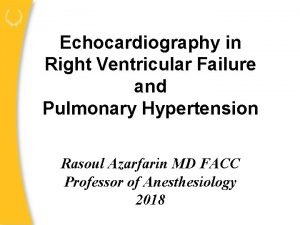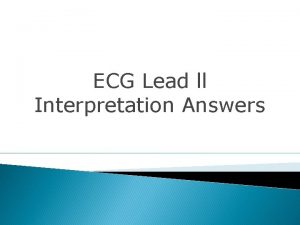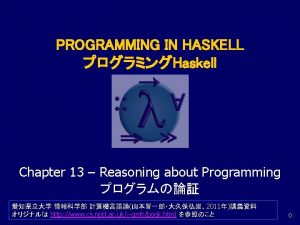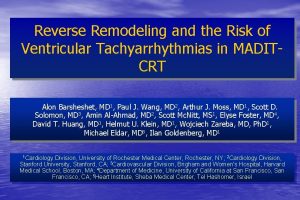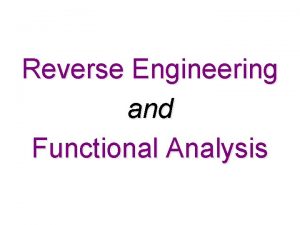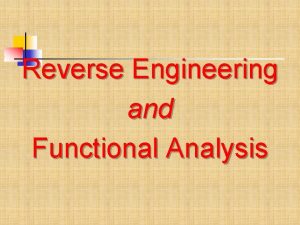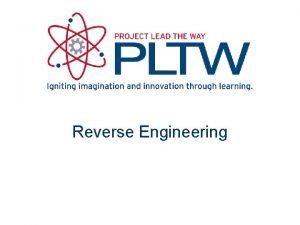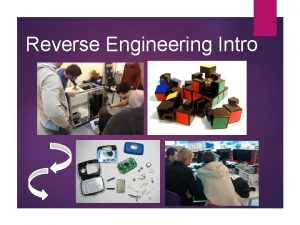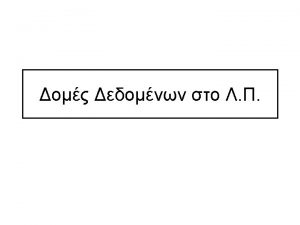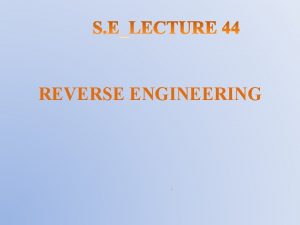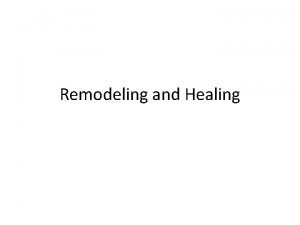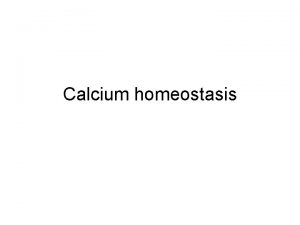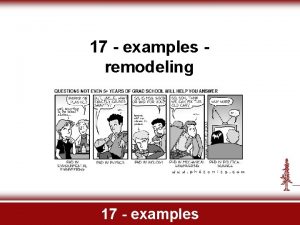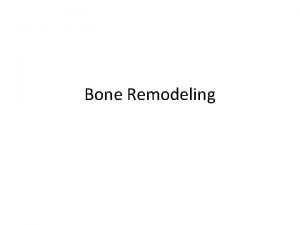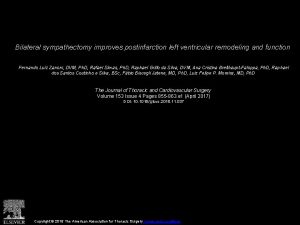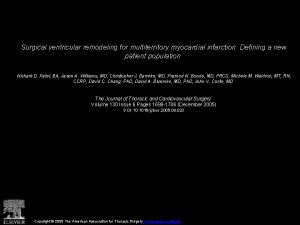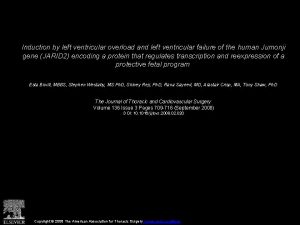Simultaneous Atrial and Ventricular Reverse Remodeling in Patients





















- Slides: 21

Simultaneous Atrial and Ventricular Reverse Remodeling in Patients receiving Cardiac Resynchronization Therapy Mariëlle Kloosterman, Michiel Rienstra, MD, Bart A. Mulder, MD, Isabelle C. Van Gelder, MD, Alexander H. Maass, MD. University Medical Center Groningen, The Netherlands

Overview § § § Background § Heart Failure § Cardiac Resynchronization Therapy § Reverse Remodeling Aim Methods & Definitions Results Conclusions Q&A

Heart Failure Watchlearnlive – American Heart Association ®

Left bundle branch block Sinus node AV node Conduction block Stimulation therapy

Electrical (dys)synchrony Steffel J. and Leclercq C. Eur Heart J. 2014; 35: 13 -15.

Reverse Remodeling Left ventricular reverse remodeling reduction of left ventricular end systolic volume of ≥ 15% after six months Drakos S. G. , Khoury A. G. , Stehlik J. et al. Circulation. 2012; 126: 2230 -241.

Randomised Controlled Trials Studies (n randomized) Year Effects of CRT MUSTIC SR (58) 2001 § ↓ NYHA Class MIRACLE (453) 2002 PATH CHF (41) 2002 MUSTIC-AF (59) 2002 MIRACLE-ICD (369) 2003 CONTAK CD (490) 2003 PATH-CHF II (86) 2003 COMPANION (1520) 2004 MIRACLE-ICD II (186) 2004 CARE-HF (814) 2006 § Reverse Remodeling (± 60%) ↓ LVESV REVERSE (610) 2008 § ↓ Heart Failure Hospitalizations MADIT-CRT (1820) 2009 RAFT (1798) 2010 § ↑ Quality of Life Score § Exercise Capacity ↑ 6 minute walking distance ↑Peak VO 2 § LV function ↑ Ejection Fraction ↓Mitral regurgitation § ↓ Mortality NYHA = New York Heart Association, LV = left ventricular; LVESV = left ventricular end systolic volume

Aim However. . The effect of (simultaneous) left atrial reverse remodeling has not been adequately evaluated Aim § Explore the prognostic effect of atrial reverse remodeling on all-cause mortality or heart failure hospitalizations during CRT in patients with atrial fibrillation (AF) or sinus rhythm. Møller J. E. , Hillis G. S. , Oh J. K. , et al. Circulation. 2003; 107: 2207 -2212.

Methods & Definitions Methods § Single-center, retrospective, observational study § 365 patients receiving a CRT(-D) § Primary outcome § composite endpoint of all-cause mortality and heart failure hospitalizations Definition of response § Ventricular reverse remodeling - a reduction of LVESV of ≥ 15% after 6 months § Atrial reverse remodeling - a reduction of left atrial volume index (LAVI) of ≥ 10%* after 6 months Additional analyses with LAVI reduction >0%, ≥ 5%, and ≥ 15%. *

Left Atrial Volume Index (LAVI) (ml/m²) Biplane method of discs (modified Simpson's rule) Image: Lang R. M. , Bierig M. , Devereux R. B. , et al. Eur Heart J Cardiovasc Imaging. 2006; 79 -108.

Degree of atrial and ventricular (reverse) remodeling LAVI = left atrial volume index; LVESV = left ventricular end systolic volume

Results - Baseline characteristics Atrial and ventricular reverse remodeling Only atrial reverse remodeling No atrial and ventricular reverse remodeling (n=76) (n=125) (n=40) (n=124) 65. 4 ± 11. 0 65. 0± 11. 2 61. 9± 11. 4 66. 0± 10. 7 0. 23 Male sex – no. (%) 52 (68) 92 (74) 30 (75) 94 (76) 0. 71 History of AF – no. (%) 23 (30) 54 (43) 11 (28) 56 (45) 0. 06 Ischaemic cardiomyopathy – no. (%) 33 (43) 55 (44) 18 (45) 68 (55) 0. 27 Age – yr – mean±SD NYHA class– (%) II / IV p-value for trend 0. 59 34 / 65 / 1 40 / 55 / 5 40 / 57 / 3 31 / 64 / 5 Heart rate – mean±SD –bpm 74± 17 75± 15 77± 12 75± 13 0. 69 QRS duration -mean±SD- ms 166± 24 160± 26 162± 22 153± 24 0. 006 LV end systolic volume – mean ± SD– ml 190± 91 184± 83 171± 95 155± 69 0. 01 Left atrial volume index – mean ±SD – ml/m 2 44± 17 40± 21 45± 14 43± 19 0. 39 LV ejection fraction - mean ±SD - % 24± 10 24± 9 22± 8 25± 10 0. 221 Electrocardiogram Echocardiographic parameters AF = atrial fibrillation; bmp = beats per minute; LV = left ventricular; NYHA = New York Heart Association; SD = standard deviation

Determinants of atrial- and ventricular reverse remodeling Multivariate analysis Atrial reverse remodeling OR (95% CI) p-value LVESV (per 25 ml increase) 1. 17 (1. 08 -1. 26) <0. 001 Left atrial length (per 5 ml increase) 0. 84 (0. 75 -0. 94) 0. 002 0. 64 (0. 41 -1. 0) 0. 050 QRS duration (per 10 ms increase) OR (95% CI) p-value 1. 14 (1. 03 -1. 27) 0. 012 Ventricular reverse remodeling Mitral regurgitation 2. 1 (1. 23 -3. 68) 0. 007 History of AF 0. 56 (0. 32 -0. 97) 0. 039 Ischemic cardiomyopathy (CAD or MI) AF = atrial fibrillation; CAD = coronary artery disease; CI = confidence interval; LVESV = left ventricular end systolic volume; MI = myocardial infarction; OR = odds ratio

Atrial Fibrillation Burden Atrial and Only No atrial and AF Burden 6 months – ventricular atrial ventricular tertiles - % reverse remodelling (n=24) (n=53) (n=16) (n=58) <2% 5 (21) 20 (38) 6 (38) 14 (24) 2 -99. 9% 13 (54) 9 (17) 9 (56) 22 (38) 100% 6 (25) 24 (45) 1 (6) 22 (38) p-value for trend 0. 005

All-cause mortality or heart failure hospitalizations • Mean follow-up: 2. 0 ± 1. 0 years – 49 patients died (19 with AF) – 24 patients were hospitalized

Multivariate Cox Regression models All-cause mortality or Atrial and ventricular reverse remodelling versus no atrial and ventricular reverse remodelling heart failure hospitalisations HR (95% CI) p-value Model 1 3. 3 (1. 4 -8. 0) 0. 007 Model 2 3. 1 (1. 3 -7. 5) 0. 01 Model 3 3. 1 (1. 3 -7. 6) 0. 01 Atrial reverse remodelling ≥ 10% reduction HR= hazard ratio; CI = confidence interval Model 1 - not adjusted Model 2 - adjusted for gender and age at implantation Model 3 - adjusted for gender, age at implantation, mitral regurgitation, ischemic cardiomyopathy, and atrial fibrillation.

Explanation? Diastolic filling E = early component of LV filling A = atrial component of LV filling

Atrio-ventricular interval optimisation E = early component of LV filling A = atrial component of LV filling

Conclusions 1. There is discordance in atrial and ventricular reverse remodelling in a significant number of patients who receive CRT 2. The event free survival of patients with only atrial reverse remodelling did not significantly differ compared to patients with both atrial and ventricular reverse remodelling 3. Adverse atrial and ventricular remodelling seems to be an important contributor to a worse outcome in patients receiving CRT 4. Ventricular reverse remodelling should not merely be the focus in assessing outcome after CRT. Atrial reverse remodelling may provide additional prognostic information

Thank you for your attention

Q&A
 Nucleosome remodeling
Nucleosome remodeling Remodeling phase
Remodeling phase Estectomy
Estectomy Bone remodeling
Bone remodeling Bone remodeling facial exercise
Bone remodeling facial exercise S-n-s remodeling
S-n-s remodeling Figure 6-2 structure of a typical bone
Figure 6-2 structure of a typical bone Bone remodeling
Bone remodeling Aging in place remodeling idaho
Aging in place remodeling idaho Bone remodeling
Bone remodeling Drenaj ventricular extern
Drenaj ventricular extern H's and t's
H's and t's Failure to capture vs failure to sense ecg
Failure to capture vs failure to sense ecg V flutter
V flutter Inotrop batmotrop cronotrop dromotrop
Inotrop batmotrop cronotrop dromotrop Ventricular escape rhythm ecg
Ventricular escape rhythm ecg Ventricular shunting
Ventricular shunting B-bloqueadores
B-bloqueadores Tratamiento de taquicardia sinusal
Tratamiento de taquicardia sinusal Taquicardia ventricular polimorfa
Taquicardia ventricular polimorfa Elevated right ventricular systolic pressure
Elevated right ventricular systolic pressure How to count rate on ecg
How to count rate on ecg
